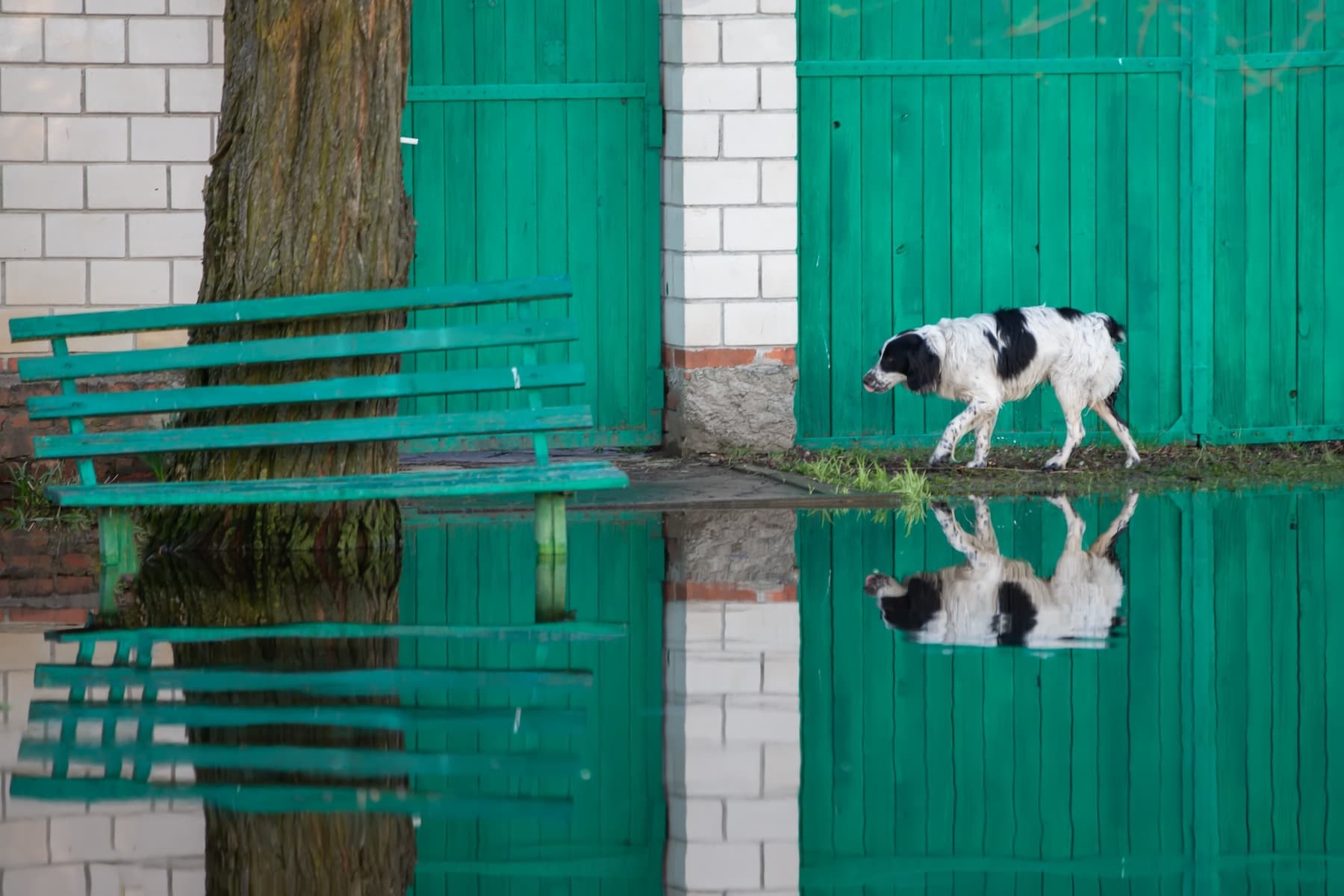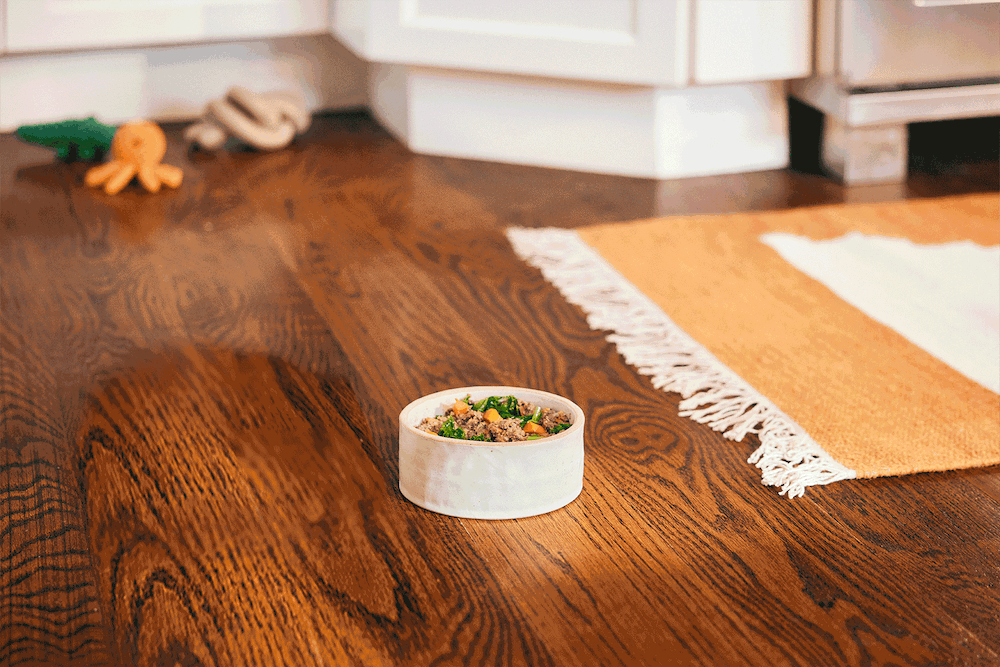
In this article:
- Flash flood warnings have broken records this year.
- How should I prepare myself and my dog for a flood?
- What do I do with my dog during a flood?
- How do I travel with The Farmer’s Dog food in an emergency?
- What should I do with my dog after a flood?
Before dawn on July 14, the staff at the Hope 4 Paws Humane Society in Plainfield, New Jersey responded to an alarm at their facility. The National Weather Service had issued flash flood warnings for North Jersey, but when staffers arrived they were shocked to find rising water surrounding the shelter.
According to their story, posted on Facebook and picked up by local news, four members of the Hope 4 Paws team swam through the swamp, past debris, to find the animals sheltered there trapped in their cages. At the time of the rescue, the water had already reached some dogs’ chests.
Thankfully, the humans were able to move the animals to safety. And an outpouring of support from the community far exceeded the donations they’d asked for, so—despite devastating damage—they’re well on their way to rebuilding. But the way the waters so suddenly threatened the animals’ safety serves as a reminder of flash floods’ dangers.
This year has seen a record number of flash flood warnings
Sadly, it appears that flash floods are becoming more common than ever. Michael Lowry, a meteorologist for a Miami ABC affiliate, recently reported that the National Weather Service has issued more flash flood warnings in 2025 than any year since recordkeeping began in 1986.
The United States has already seen multiple flash floods this summer. In addition to New Jersey, these disasters have swept away lives and destroyed livelihoods and homes in Texas and North Carolina. The danger is real and terrifying: In Texas, the Guadalupe River rose 26 feet (more than the height of a two-story house) in just 45 minutes.
Dogs and other pets are especially vulnerable to the impacts of flooding, whether they are in shelters or homes at the time of an emergency. They rely on their humans to get to safety. And, by definition, flash floods happen quickly—making preparation especially crucial. Below, find information on how to protect your dog before, during, and after a flood emergency.
How to protect your dog: Before the flood
Your dogs are important members of your family, so they need to be included in your emergency plan. According to FEMA, a comprehensive emergency plan should include evacuation routes and identify pet-friendly shelters or hotels outside the flood zone—ahead of the disaster. Is there someone trusted (like a neighbor) that can get your dog to safety if you are not home? If so, the American Veterinary Medical Association (AVMA) recommends that you give them a signed letter “that will release them from responsibility if a pet is injured during an evacuation and that tells them the location of your evacuation kit.”
Because you plan to take your dog with you, you should have an emergency kit full of essential supplies for their needs. The AVMA has a free, downloadable guide to disaster preparedness for your pet, but here are some of the items that should go in your kit:
- At least three days’ worth of food and water (a note on transporting fresh food below)
- Medications and medical records in a waterproof container
- Collar with ID tags and a leash
- Carrier or crate for transport (bonus points if it’s collapsible for easy transport; dogs should be able to stand up in it)
- Recent photos of your pet
- Comfort items like favorite toys or blankets
Make sure that your dog has a collar with an ID tag, and consider microchipping them—a 2021 study found that dogs with microchips were much more likely to be returned to their owners than those without.
April Peiffer, Community Engagement Coordinator at the Williamson County Regional Animal Shelter, which was impacted by the July Fourth flood of the Guadalupe River, was surprised by how many pets caught in the disaster lacked IDs.
“You never know when a weather disaster could strike,” Peiffer said. “Microchips and collars are such a vital part of the work we do at the shelter to help reunite pets with their families.”
How to protect your dog: During the flood
Never leave your dog behind during an evacuation. In past disasters, pet owners have chosen not to comply with recommended evacuations if accommodations for their pets could not be guaranteed—which increased risks for evacuees, responders, and animals. This dangerous situation led to the passage of the Pets Evacuation and Transportation Standards (PETS) Act of 2006, which authorizes FEMA to rescue, shelter, and care for people with pets and service animals, and the animals themselves, after a major emergency.
If your pets are outside, bring them inside while you evaluate the situation. Stress can cause a dog to bolt, so make sure they are secure inside (meaning ensure that they can’t escape by any means while under duress). If you make the decision to evacuate with your dog:
- Keep your dog with you on a leash or in a carrier at all times.
- Bring your emergency supplies and important documents in a waterproof envelope.
- Head to your predetermined evacuation location.
- Inform emergency services if you need assistance evacuating with your pet.
Specifically during a flood, be sure to:
- Move to the highest level of your home.
- Call emergency services immediately.
- Keep your dog calm and close to you.
- Do not attempt to wade through water with your pet (debris and other hazards can be unseen in standing water; moving water, even water that appears low, can knock you and your pet down or sweep you away).
- Wait for professional rescue teams who are equipped to handle both human and animal evacuations.
How to travel with The Farmer’s Dog food in an emergency
No matter what’s going on, your dog needs to eat. Depending on the specific circumstances at hand, your feeding schedule may be affected—but you can take measures so that your friend will have enough food.
If you’re feeding fresh, losing power to your refrigerator or freezer could disrupt your routine. The CDC has advice for how to keep your frozen and refrigerated food edible during a power outage. Generally, food can stay colder longer if it’s packed closely with other cold items in a freezer, refrigerator, or cooler. Placing food in a freezer bag can add insulation. If you feed The Farmer’s Dog, check to make sure that your food is still cold to the touch before feeding. And, if it smells bad or the pack has puffed up, toss it—better safe than sorry.
If you’re on the go and have the room, you can bring some food packed in a cooler with ice or cold packs. Remember to follow the same guidelines to judge its freshness.
If you have access to ingredients and a kitchen, but can’t get your delivery, you can home-cook temporarily for your dog. Here are some recipes. This isn’t a great long-term solution, as it’s very difficult to formulate a nutritionally complete diet for a dog in your own kitchen, but it’s okay in the short term.
How to protect your dog: After the flood
Once the immediate danger has passed, inspect your dog for injuries and contact your veterinarian if you notice any health concerns. If you have any concerns about your pet’s wellbeing (even if you don’t see visible injuries), the safest thing to do is to take them in for a vet exam. Be patient with your pet, as dogs can experience stress and anxiety following traumatic events.
Be prepared, but don’t panic
It can be scary to think about a disaster like a flood—but making a plan ahead of time will increase the chances that, if you are faced with a disaster, you and your dog will come out of it safe and happy.




